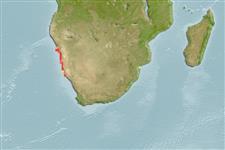分类 / Names
俗名 | 同种异名 | Catalog of Fishes(属, 种) | ITIS | CoL | WoRMS | Cloffa
Teleostei >
Eupercaria/misc (Various families in series Eupercaria) >
Sparidae (Porgies)
Etymology: Chrysoblephus: Greek, chrysos = golden + Greek, blepo, blepharizo = to watch (Ref. 45335).
More on author: Valenciennes.
Environment: milieu / climate zone / depth range / distribution range
生态学
海洋 居于水底的; 深度上下限 1 - 100 m (Ref. 3198). 熱帶; 21°S - 28°S
Southeast Atlantic: northern Namibia to northern Natal, South Africa; also reported from Mauritius.
東南大西洋: 那米比亞到納塔爾北部北部, 南非; 也記錄自模里西斯。
Length at first maturity / 大小 / 重量 / 年龄
Maturity: Lm 18.1 range ? - 22.5 cm
Max length : 50.0 cm TL 雄鱼/尚未辨别雌雄; (Ref. 3507); common length : 32.0 cm TL 雄鱼/尚未辨别雌雄; (Ref. 3507); 最大体重: 4.2 kg (Ref. 3670)
背棘 (总数): 11 - 12; 背的软条 (总数): 10-11; 臀棘 3; 臀鳍软条: 7 - 9. Usually reddish orange in color, but sometimes blue with a white patch on the side (Ref. 3198).
通常橘红色颜色, 但是有时蓝色的侧边上具有一个白色斑块.(参考文献 3198)
Occurs above rocky bottoms in deeper water to 100 m but often caught from shore. Juveniles occur in shallow-water beds of seaweed where they feed on minute crustacean (Ref. 3670). Feeds on mollusks, crustaceans, worms and fish. Females transform into territorial males with growth (Ref. 3198). Voracious but sluggish, takes any bait. Good food fish (Ref. 3198). Sold fresh (Ref. 3507). It is parasitised by the monogenean Anoplodiscus cirrusspiralis on the fins and body surface (Ref. 124057).
在上面岩石底部生存在深水中到 100 公尺但是时常从海岸捕捉了。 稚鱼出现在海草的浅水床在哪里它们吃细小的甲壳动物.(参考文献 3670) 吃软件动物,甲壳动物,蠕虫与鱼。 雌性随着成长转换成具有领域性的雄性。 (参考文献 3198) 狼吞虎咽的但是缓动性的, 吃任何的诱饵。 好食用鱼.(参考文献 3198) 生鲜贩卖了。 (参考文献 3507)
Life cycle and mating behavior
成熟度 | 繁殖 | 产卵场 | 卵 | 孕卵数 | 仔鱼
Also Ref. 28504.東南大西洋: 那米比亞到納塔爾北部北部, 南非; 也記錄自模里西斯。
Bauchot, M.-L. and M.M. Smith, 1984. Sparidae. In W. Fischer and G. Bianchi (eds.) FAO species identification sheets for fishery purposes. Western Indian Ocean (Fishing Area 51). volume 4. [var. pag.] FAO, Rome. (Ref. 3507)
人类利用
渔业: 商业性; 游钓鱼种: 是的; 水族馆: 潜在的
更多信息
参考文献养殖养殖信息品种遗传学Electrophoreses遗传率疾病加工NutrientsMass conversion
合作者照片Stamps, Coins Misc.声音神经毒速度泳型鳃区Otoliths脑重体重比眼睛色素
工具
特别资料
下载 XML
网络资源
Estimates based on models
Phylogenetic diversity index (Ref.
82804): PD
50 = 0.5156 [Uniqueness, from 0.5 = low to 2.0 = high].
Bayesian length-weight: a=0.01778 (0.01107 - 0.02856), b=3.00 (2.86 - 3.14), in cm total length, based on LWR estimates for this species & Genus-body shape (Ref.
93245).
营养阶层 (Ref.
69278): 4.0 ±0.0 se; based on diet studies.
回复力 (Ref.
120179): 中等的, 族群倍增时间最少 1.4 - 4.4年 (K=0.16).
Fishing Vulnerability (Ref.
59153): Moderate to high vulnerability (54 of 100).
Nutrients (Ref.
124155): Calcium = 105 [50, 201] mg/100g; Iron = 0.941 [0.508, 1.907] mg/100g; Protein = 18.7 [17.4, 19.9] %; Omega3 = 0.199 [0.111, 0.369] g/100g; Selenium = 57.6 [26.0, 123.7] μg/100g; VitaminA = 14.8 [3.9, 54.0] μg/100g; Zinc = 0.862 [0.566, 1.286] mg/100g (wet weight);
